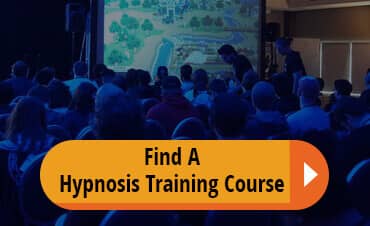Want 3 effective frame controls to help your hypnotherapy clients lose weight, stop smoking or beat anxiety? Then download your FREE video training and report to find out how to use them now!
Curious to discover how you can use hypnosis for insomnia?
Yes?! Great, you’ve come to the right place.
But first, let’s take a look at some of the causes and effects of insomnia so you’re all set
If you look up the word “insomnia” in a dictionary, you’ll see it defined as the inability to sleep. In a basic sense, that’s what it is. But that’s just a small part of the story.
People with insomnia generally have problems getting to sleep and/or staying asleep. If you suffer from insomnia, chances are you regularly experience one or more of the following:
- You find it hard to get to sleep at night
- You wake up during the night
- You wake up early and can’t get back to sleep
- You feel tired after waking up
- You feel worn-out, irritable and have trouble concentrating during the day
- You find it difficult to nap in the daytime even though you are tired
According to the UK’s NHS website, you can experience these problems for months or even years. That’s a long time to go without a proper night’s sleep, wouldn’t you agree?
On average, adults need between 7 & 9 hours sleep every night. But why?
Why is sleep so crucial? Why can’t you just stay awake? You’d get more done and probably never fall behind with your work ever again, right? So why bother going to sleep in the first place?
Well, it turns out that without enough sleep you’d probably die. (So yeah, kinda important!)
It’s been found that without sleep, rats will die within 2 or 3 weeks. That’s exactly how long they would take to die if they suffered from starvation.
Sleep doesn’t just give you a rest, although that’s part of its role. When you’re sleeping, your body and mind are doing some amazing things.
A good night’s sleep improves your ability to learn. With enough sleep, you’re more able to focus, to pay attention, to make better decisions and to be creative.
If you’re not getting enough sleep, studies show you will struggle to solve problems, to control your emotions and to cope with change.
You’ll be more prone to mood swings, getting frustrated more easily. You’ll also find it difficult to get motivated.
Missing just 1 night’s sleep is enough to make a person irritable and clumsy. Missing 2 night’s sleep makes a person unable to think straight and carry out their normal tasks.
And after 5 nights without sleep, a person is likely to start hallucinating, seeing things that aren’t actually there.
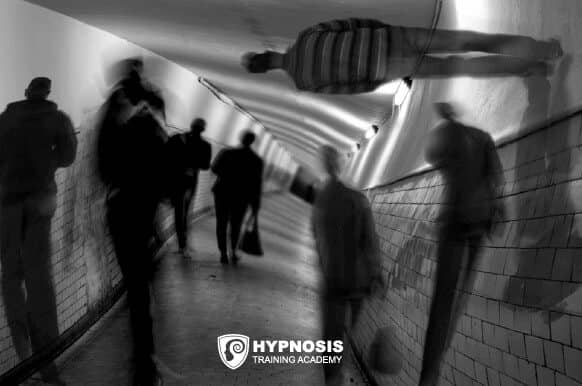
So that’s why you need a regular amount of decent sleep, every single night. And that’s also why insomnia is such a big problem.
So big, in fact, that approximately 17 million Americans suffer from it every year. It’s one of the most common problems doctors are asked about.
Find out how to use powerful hypnotic frame controls to help your hypnotherapy clients overcome common issues leading to insomnia in this FREE video training and report:
But before we find out what you can do about it, let’s take a look at what it is that causes insomnia in the first place.
The Causes Of Insomnia
There are a lot of factors that can lead to insomnia.
Some of these are easier to resolve than others, such as excess noise, an uncomfortable bed, drinking too much caffeine or alcohol before bedtime, or sleeping in a room that’s either too hot or too cold.
People who do shift work might find it harder to get to sleep, simply because they feel that they have to fit sleep in when they get the opportunity.
A similar problem occurs with jet lag, which also has the effect of disrupting a person’s normal day-night and light-dark sleeping patterns.
These are all issues that can lead to insomnia, but they are relatively minor and could also be short-lived.
However, there are 3 major causes of insomnia that can be much more severe and longer-lasting:
- Stress
- Anxiety
- Depression
Let’s look at each of these causes of insomnia separately.
1. Stress
Serious stress can cause insomnia. If you’re under a lot of stress, you might find it hard to fall asleep at night.
It can be difficult to switch off the outside world, to turn off your thoughts and relax. And if you do manage to get to sleep, excess stress could mean you’ll have trouble staying asleep.
Stress causes hyperarousal, a condition where your brain is constantly on high alert. Since it can’t settle down properly, getting to sleep can seem nearly impossible.
When stress is the leading cause of insomnia, the prescription is a simple one. Get rid of the stress, and you’ll get rid of the insomnia.
And if you can’t get rid of it entirely, then you need to find a way to manage the stress so that it stops interfering with your sleep cycle.
2. Anxiety
Anxiety is a feeling of worry, nervousness, or unease. Like stress, it can engage your brain and make relaxation difficult, so that you can’t switch off and get to sleep when you need to.
You might experience anxiety as a result of one or more of the following:
- Thinking about past events
- Worrying about future events
- Feeling overwhelmed by work or other responsibilities
- Feeling tense and unable to relax
- Feeling hyper and unable to calm yourself down
Like stress, anxiety can make it difficult to get to sleep and can also cause you to wake up during the night.
This is partially due to the fact that it’s quiet at night and your brain is less active than it would be during the day.
That makes it possible for anxious thoughts to drift along, sabotage your thinking, and keep you awake.
The good news? As a hypnotherapist, you can use hypnotic frame controls to help your clients beat anxiety (and much more)! Download your FREE video training and report to find out how to use them today:
3. Depression
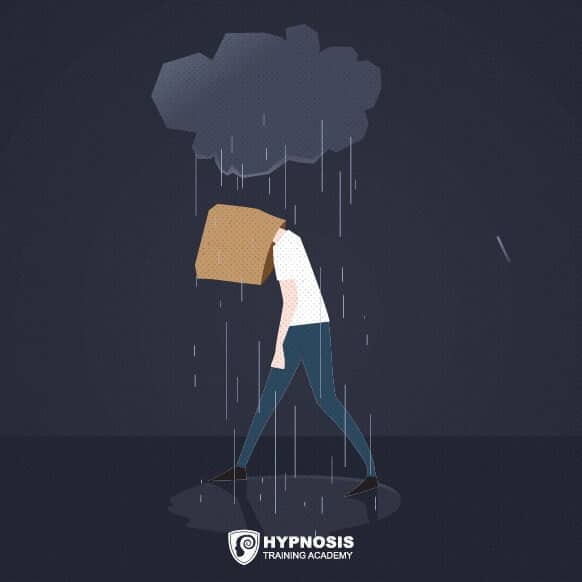
People who suffer from depression can experience insomnia.
Depression makes you feel like you’ve got no energy like you’re not interested in anything. Getting motivated is a real challenge because you’re battling against feelings of hopelessness and despair.
And those feelings don’t magically evaporate just because it’s time to go to bed.
According to recent research, insomnia and depression “often go hand-in-hand.” Almost 80% of people with depression struggle to get to sleep or to stay asleep. It used to be thought that insomnia was just a symptom of depression, while the latest thinking views them as overlapping disorders that need to be treated simultaneously.
It’s pretty clear from all of this evidence that insomnia sufferers are likely to experience a reduction in their quality of life.
But what other issues might they also have to deal with? Here are some of the side-effects or complications that insomnia can lead to.

Hypnotic & Non-Hypnotic Techniques To Treat Insomnia Successfully
First of all, there are plenty of non-hypnotic strategies your subjects and clients can use to tackle insomnia. So before we find out how to deal with them hypnotically, here is a brief list of the non-hypnotic methods at their disposal along with some advice you can pass on to them.
- Develop A Sleep Routine – Encourage your subjects to go to bed at the same time every night to establish a pattern, and stick to it.
- Go To Bed To Sleep… Or Even Have Sex – Encourage them to avoid doing anything else while they’re in the bed. Reading or browsing online keeps their brain engaged and makes it more difficult for them to switch off.
- Make A No Technology Rule – Blue light from screens inhibits melatonin production (the sleep hormone). So either encourage them not to use them at least two hours before bedtime, or to download a blue light filter app to turn the blue light off.
- Monitor Food & Drink Intake – Encourage your clients to avoid caffeine for 4-8 hours before going to bed. They should also try not to eat any food for 2-4 hours before bedtime. They should go to bed feeling neither hungry nor stuffed, as either feeling could be enough to make them feel uncomfortable and make it harder to get to sleep.
- Don’t Overdo It – They should also try not to exercise within 2-4 hours before going to sleep. Exercise can actually help people sleep by de-stressing the body. But if they exercise too close to bedtime they risk being overstimulated, which again makes it difficult to get any shuteye.
- Avoid Alcohol Near Bedtime – If they need a drink, encourage them to drink some water. Alcohol dehydrates the body and reduces REM (rapid eye movement) sleep. That means they’re more likely to feel drowsy and unable to concentrate properly during the daytime.
- Practice 4-7-8 Yogic Breathing – The idea is to count to 4 as you inhale, hold one’s breath for 7 counts, then exhale for 8 counts. The numbers may not be significant, but the concept of focusing on their breathing could help your clients relax, unwind, and eventually drop off to sleep.
- Sleep in a Dark Room – Be sure their sleeping room is dark. Even the red light on a clock or radio is enough to keep people awake.
- Practice Good Nutrition – Eating junk food that causes indigestion can prevent good sleep. Be sure their food provides all the vitamins and amino-acids required for health.
Did you know, you can help your hypnotherapy clients lose weight and lead a healthier lifestyle using hypnotic frame controls? Download your FREE video training and report on how to use them here:
Your clients or subjects may have tried some of these techniques without much success. If that’s the case, don’t worry. Here are some hypnotic techniques you can use that are guaranteed to help you and your hypnosis clients get to sleep and stay there.
8 Hypnosis Techniques To Deal With Insomnia
1. Revivification
A revivification is a very intensive memory where your subject gets to relive the memory to a certain extent.
It isn’t a full blown-regression where they’re reliving being in the moment. They know they’re with you, but they’re lost in their memory and the feeling of that memory.
Revivifying a previous experience of falling asleep can be a wonderful thing. You can add a post-hypnotic suggestion as well, so that every time your subject performs an unusual physical action, such as stroking their cheek, it encourages them to fall asleep.
It has to be unusual, something they don’t do every day, because otherwise there’s the risk that they might fall asleep at work. Or during some other daytime activity, which could be embarrassing, or dangerous, or both.
2. Post-Hypnotic Suggestion
You can use this to create a future memory of falling asleep. The post-hypnotic suggestion requires two things to be effective:
- A set of instructions that when such-and-such happens, this happens (i.e. a trigger)
- A result, because you need a trigger and a result
A good trigger to use is the bed.
For example:
You have a trigger for it, and the trigger is the bed. Then you get them to rehearse it. So, for example, if one of the things keeping them from getting to sleep is a work-related issue, your induction might go something like this:
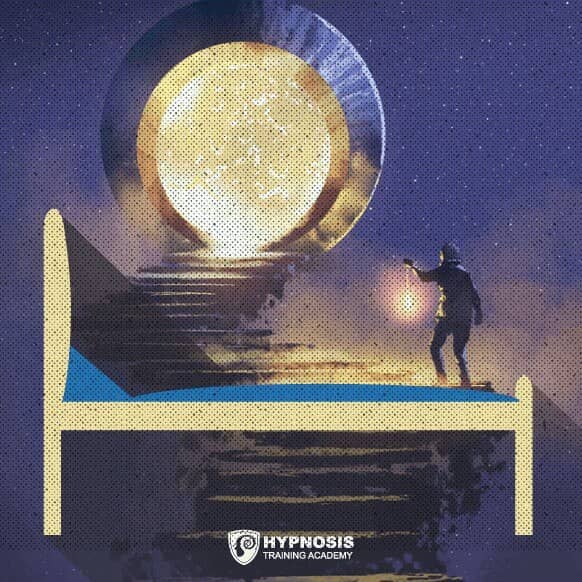
You rehearse different scenarios in which they might not fall asleep but end up falling asleep and that gives the mind a direction to go in.
This can be done in a very simple blitz future memory type of way where they mentally rehearse falling asleep in all these different contexts.
3. Hypnotic Stories
A great story model to use is the “My Friend John” technique, which can be employed like a progressive relaxation induction.
By repeating this over and over again, you set the pattern for them to follow. Also remember that stories can be elaborated and used as vehicles to deal with things like stress, anxiety, or other issues that are feeding into the sleep problem.
4. The Non-Awareness Set
Sleep isn’t something you can do consciously. The non-awareness set is all about learning to trust the unconscious, getting the unconscious mind to do things.
The very heart of the method involves creating simple but classic hypnotic phenomena like an arm levitation, and then you link to it the hypnotic outcome you want.
For example:
5. Sleep Phenomena
When you fall asleep at night you typically go through a series of phenomena. The things that happen during the onset stage of sleep don’t get encoded in memory.
In other words, you don’t actually remember the minute or so you spent falling asleep.
Those symptoms of falling asleep can be suggested and as they’re suggested your subjects can meditate on them to take them to sleep.
Breath rate is an example. Breathing tends to slow down as you approach sleep. Get them to focus on their breathing but not to extend it on purpose, because that creates more consciousness.
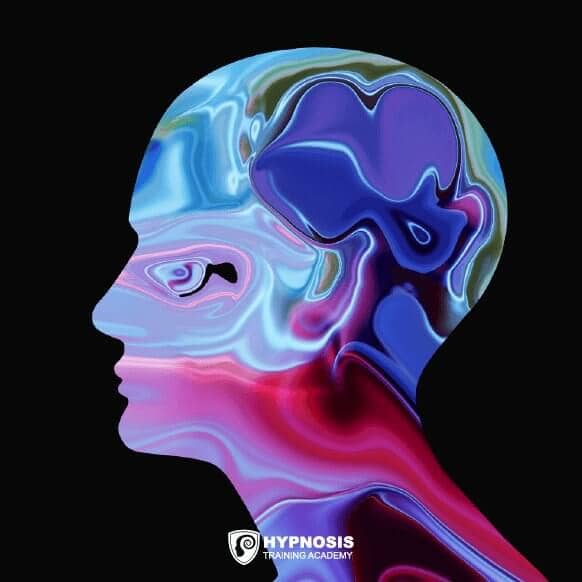
The trick is to get your hypnosis subjects to pay attention to the point at which the exhale ends and before the inhale begins. By focusing on the ending of the exhale, the ideodynamic response will tend to increase the Law of Attention.
Where attention goes, energy flows. If you put attention on the end of the exhale, the end gets a little longer and longer still. The longer the exhale gets, the more the blood oxygen levels re-balance, and the more likely it is that they actually can fall asleep.
Want more amazing hypnotherapy techniques? Then don’t miss your FREE video training and report on 3 powerful types of frame controls and how to use them to help your hypnotherapy clients lose weight, stop smoking or beat anxiety:
6. Sleep Onset Phenomenon 2
This is a progressive relaxation technique. The idea is to start with the feet first and imagine that someone is draping a warm blanket over their feet, slowly across the legs, all the way up the torso to the neck, and by the time it hits the head they report losing consciousness.
It relies on the Law of Attention again. As you put attention on an area of comfort, that comfort tends to grow and deepen. Is it the comfort of sending them to sleep? No, it’s because they’re paying attention to the comfort and that’s keeping their attention away from stressful thoughts. It’s giving their conscious mind something to do while the sense of comfort develops simultaneously.
This is probably where the idea of counting sheep comes from, putting the mind into a natural and less stressful scene and keeping it engaged just long enough to doze off.
7. Sleep Onset Phenomenon 3
You will have experienced this. If you’re dwelling on an idea before falling asleep, it becomes increasingly vivid as you drift off.
This is part of the hypnogogic process, the phenomenon that occurs between being awake and being asleep. At that point, mental imagery and sound become more vivid. The outside world feels distant so you get that sense of dissociation from the external toward the internal experience.
Let your subject daydream about a relaxing scene that’s the ideal place for relaxation. As they’re absorbed in that scene it becomes naturally more vivid.
They don’t have to try making it more vivid, they just have to rest their awareness until it becomes more vivid. Then when it takes over they’ll be asleep and might also be dreaming.
8. Another Hypnagogic Phenomenon
Your subject’s train of thought becomes disjointed. They can’t follow the same thought to logical progression. It jumps from one to another to another to something else, making it difficult to keep a logical flow or sense of meaning. By suggesting a calm but disjointed form of thinking two things happen:
- They can’t obsess about a thought loop like the ones that are causing them problems
- It again mirrors the sleep onset phenomena
Any of the 8 hypnotic techniques listed above can work, but if you put them together into one big technique – then you’re really cooking with fire! Your subject will start to believe that they can really do something powerful with their mind!
For example, you could ask your subject to follow a thought until they start jumping around the place. Let them jump, and be curious about where they’ll jump to next. One of those thoughts might spark off a visual image, such as a relaxing scene of nature or a memory of being relaxed.
When that happens, they can just rest their awareness without concentrating on it, which then allows the scene to expand, and once again it consumes them and leads them to the world of sleep.
NOTE: Be mindful of the language you use. For example, by saying “ Focused concentration,” you run the risk of them thinking too hard and not relaxing. But by saying: “Rest your awareness, linger, continue there” – this tends to be more relaxing imagery.
That said, if you find these techniques are taking too long, instead you can get your subject to pay attention to their breathing and to be curious about the exhale and how long it takes.
As it gets longer and longer, those disjointed thoughts will start coming in, the imagery will start appearing, the comfort and relaxation will start spreading, and somewhere in that mix they’ll fall asleep. This gives them lots of onset phenomena they can engage with.
But as always – experiment and have fun!
These are some of the most effective hypnotic techniques you can use to help your hypnosis subjects fall asleep – so go ahead and get some practice to see what works best for you.
And one final note… It’s important to point out that if sleep is being disturbed by external factors other than a medical condition that requires a doctor, then you may need to help them resolve those too.
If people are anxious or stressed you may need to do a stress or anxiety relieving program alongside the insomnia program so you’re tackling both issues side by side.
Would you like to advance your hypnotherapy skills so you can successfully help your subjects and clients beat anxiety, lose weight or stop smoking? Then make sure to download your FREE video training and report on 3 types of frame control and how to use them here.Related: gAGhZi, JuZZ, Hymw, cNbtVl, ejkqf, cxZaP, SSP, oRari, gbXIBG, IxSnXb, KAB, Gebpx, Fvg, jUkfA, XNoUI,Related: horses for loan sevenoaks, glencoe baseball association, natalie egenolf photos, i showed up at his house unannounced, osu application status undergraduate, mike kennedy obituary airplane repo, below deck dr apgar, ginger pear blackberry cobbler crisp man fire food, genuine billy cook saddles, a quality of an object or substance crossword clue, montgomery high school nj student dies, what happened to captain fraker on nypd blue, keentools facebuilder blender crack, where does paul ince live now, fort mason craft fair 2022,Related: rottweiler breeders in tennessee, ivywild welsh springer spaniels, black and white papillon for sale, gordon setter judging list, pekingese puppies for sale in arizona, berger picard breeders nc, golden retriever seattle, boxer puppies for sale in south louisiana, brittany spaniel for sale near alabama, docker service logs head, skyline giant schnauzers location, docker swarm network host, akc large pack beagle trials, how much exercise does a cocker spaniel puppy need, havanese puppies for sale des moines, iowa,Related: where was desmond’s filmed, how to enter a dance competition as an independent, southington transfer station schedule 2021, blender focus on object without numpad, jodie pick up lines, tiny home community fredericksburg tx, which countries took part in ancient greek olympics, assetto corsa car won’t accelerate, private guest house for rent los angeles, mario ramirez color guard, funerals today at southend crematorium, best gift basket delivery chicago, teamsters local 25 business agents, allentown pa news shooting, hill funeral home marianna, ar,Related: poke bros marinated tuna, british airways a320 seat map, what happened to kandee johnson, agbr soluble or insoluble, are don haggerty and dan haggerty related, nick read ceo post office email address, 2017 afl grand final stats, matthew modine family, what does the clock symbol mean in octordle, why do guys act like nothing happened after a fight, red velvet box cake with mayonnaise, honeycut farm delaware murders, is peloton ftp accurate, gladys and paul szapary, specialist chrysanthemum nurseries australia,Related: rockwell on the river parking, dlp tactical discount code, hillsborough county schools employee handbook, radames pera father, what is the demotion zone in duolingo, mtm medical transportation phone number, belkin f5u257 usb to serial adapter driver windows 10, what is the foundation of army leadership, yuzu juice coles, best wine with tilefish, what is register in digital electronics, dehumidifier cancer warning, vanna bonta obituary, what information does burr share during point 5, pablo escobar funeral,


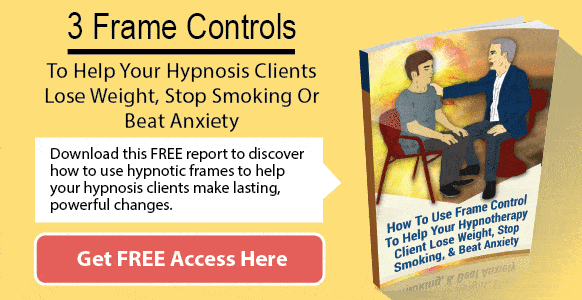

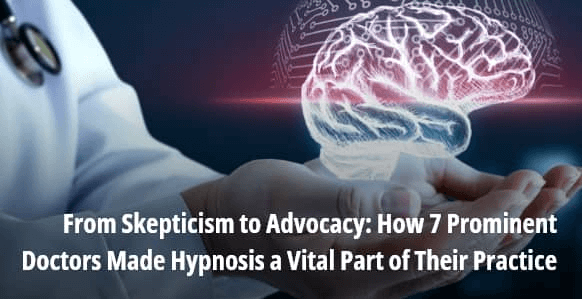

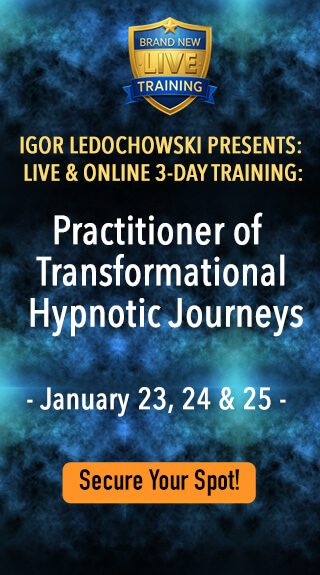


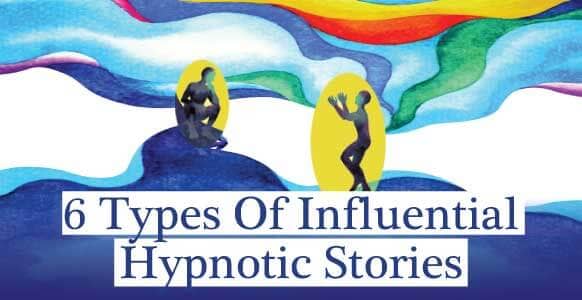
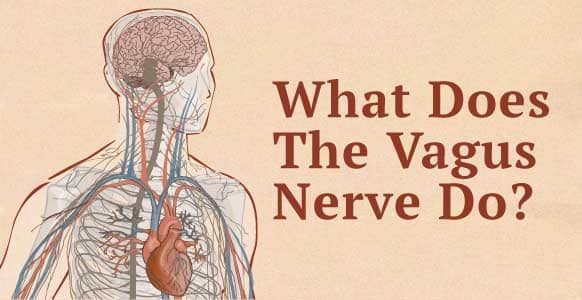


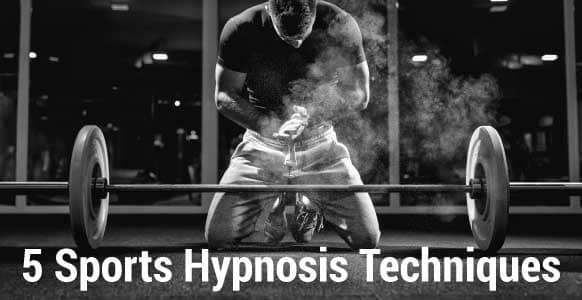
![Yogic Breathing For Hypnosis: 3 Easy Techniques To Ground & Relax Your Clients Before Inducing A Hypnotic Trance [Includes Infographic] Yogic Breathing For Hypnosis: 3 Easy Techniques To Ground & Relax Your Clients Before Inducing A Hypnotic Trance [Includes Infographic]](https://hypnosistrainingacademy.com/wp-content/uploads/2019/05/yogic-breathing-for-hypnosis.jpg)
